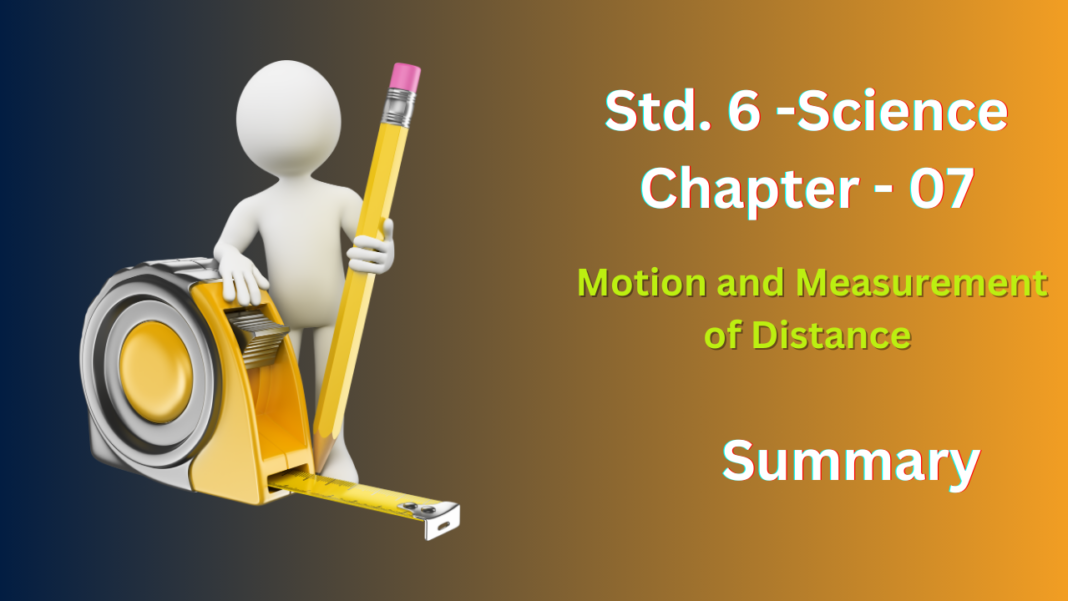NCERT Solutions for Class 6 Science Chapter 7
This chapter motion and measurement of distance delves into the concepts of motion and distance measurement, laying the foundation for understanding movement in the natural world.
1. Motion:
Objects can be at rest (not moving) or in motion (changing position).
The chapter might introduce different types of motion, such as:
Rectilinear: Movement in a straight line (e.g., walking, car driving).
Circular: Movement in a circular path (e.g., clock hands, Ferris wheel).
Periodic: Movement that repeats itself regularly (e.g., swinging, heartbeat).
2. Distance:
It measures the gap between two points.
The chapter Motion and measurement of distance introduces the meter (m) as the standard unit for measuring distance.
Other units like centimeters (cm) and kilometers (km) might also be mentioned.
3. Measuring Distance:
The chapter Motion and measurement of distance discusses various tools and methods for measuring distance, such as:
Ruler: Used for measuring small distances in centimeters or millimeters.
Meter stick: Used for measuring larger distances in meters.
Tape measure: A flexible tool for measuring various lengths and distances.
4. Importance of Measurement:
Accurately measuring distances is crucial in various daily activities, such as construction, sports, and scientific experiments.
The understanding of units and proper measuring techniques is emphasized.
5. Transportation:
The chapter Motion and measurement of distance might also briefly touch upon the history and evolution of transportation, highlighting various modes of travel from animal-drawn carriages to modern advancements like automobiles and airplanes.
Additional points:
The chapter Motion and measurement of distance might introduce the concept of speed, which relates distance to time, although a detailed exploration might be reserved for later grades.
The use of diagrams and illustrations to explain different types of motion and measurement tools is common in textbooks at this level.
NCERT Solutions for Class 6 Science Chapter 7 : Motion and measurement of distance
Exercises
1 .Give two examples each, of modes of transport used on land, water and air.
Ans: Here are two examples each of modes of transport used on land, water, and air:
Land:
- Cars: Commonly used for personal and group travel on roads.
- Buses: Larger vehicles used for public transportation or longer journeys.
Water:
- Ships: Large vessels used for transporting goods or passengers over long distances across oceans.
- Boats: Smaller vessels used for various purposes like fishing, recreation, or transportation in rivers and lakes.
Air:
- Airplanes: Used for fast travel over long distances and between different countries.
- Helicopters: Versatile aircraft capable of taking off and landing vertically, often used for rescue missions, transportation to remote locations, and observation.
2. Fill in the blanks
(i) One metre is____cm
(ii) Five kilometre is____m
(iii) Motion of a child on a swing is____
(iv) Motion of the needle of a sewing machine is____
(v) Motion of wheel of a bicycle ____
Ans :
(i) 100 cm.
(ii) 5000 m.
(iii) Periodic motion.
(iv)Rectilinear motion.
(v) Circular motion.
3. Why can a pace or a footstep not be used as a standard unit of length?
Ans : 1. Inconsistency: The length of a pace or footstep varies greatly from person to person:
- Individual differences: People have different leg lengths, walking styles, and stride lengths, resulting in paces of varying distances.
- Age and physical condition: Footstep length can change with age and physical condition, further increasing inconsistency.
2. Impracticality:
- Measurement difficulty: Accurately measuring someone’s individual pace is impractical and time-consuming.
- Communication difficulties: Sharing measurements using paces or footsteps would be difficult and confusing due to the inherent variability.
3. Standardization:
- Scientific consistency: Science requires standardized units like the meter to ensure consistent and reliable measurements across different experiments and individuals.
- Global communication: Using a single, universally accepted unit like the meter facilitates clear communication and comparison of measurements around the world.
4. Arrange the following lengths in their increasing magnitude
1 metre, 1 centimetre, 1 kilometre, 1 millimetre.
Ans :
1 millimetre (mm)
1 centimetre (cm)
1 metre (m)
1 kilometre (km)
5. The height of a person is 1.65m .Convert it into cm and mm.
Ans : Here’s the height of the person expressed in centimeters (cm) and millimeters (mm):
In centimeters (cm):
1.65 m*100 cm/m = 165 cm
In millimeters (mm):
1.65 m * 1000 mm/m = 1650 mm
6. The distance between Radha’s home and her school is 3250 m. Express this distance into km.
Ans : The distance between Radha’s home and school can be expressed as:
3.25 kilometers (km)
Here’s the conversion:
1 kilometer is equal to 1000 meters
Distance (km) = 3250 m / 1000 m/km
Distance (km) = 3.25 km
7. The length of a knitting needle, the reading of the scale at one end is 3.0cm and at the other end is 33.1 cm. What is the length of the needle?
Ans : To find the length of the knitting needle, we simply subtract the reading at the beginning of the needle from the reading at the end:
Length of needle = Reading at end – Reading at beginning
Length of needle = 33.1 cm – 3.0 cm
Length of needle = 30.1 cm
8. Write the similarities and differences between the motion of a bicycle and a ceiling fan that has been switched on.
Ans : Similarities:
- Rotational motion: Both the bicycle wheel and the ceiling fan blades exhibit.
- rotational motion. This means they move in a circular path around a fixed axis. In the bicycle, the axis is the hub of the wheel, and in the fan, the axis is the motor shaft.
Differences:
- Overall movement:
- Bicycle: The bicycle itself undergoes translational motion, meaning it moves from one location to another in a straight line or along a curved path. The wheel’s rotation contributes to this forward movement.
- Ceiling fan: The fan itself remains stationary, with only the blades rotating and not changing the overall position of the fan.
- Purpose of rotation:
- Bicycle: The wheel’s rotation is directly linked to the forward movement of the bicycle. As the pedals are turned, the chain rotates the wheel, causing it to spin and propel the bicycle forward.
- Ceiling fan: The rotation of the blades is intended to circulate air within the room. The fan’s rotation does not directly contribute to its own movement or the movement of objects around it.
- Control of motion:
- Bicycle: The rider can control the speed and direction of the bicycle’s movement through the use of the pedals and handlebars.
- Ceiling fan: The control of the fan’s motion (speed and direction) is usually done through a switch or remote control, independent of any external force applied directly to the blades.
9. Why would you not like to use a measuring tape made of an elastic material like rubber to measure distance? What would be some of the problems you would meet in telling someone about a distance you measured with such a tape?
Ans : Using a measuring tape made of an elastic material like rubber for accurate distance measurement is not ideal due to several problems:
1. Inconsistency: Rubber is elastic, meaning it can stretch and contract under pressure. This stretching and contraction affect the length of the tape itself, making it unreliable for precise measurements.
2. Difficulty in maintaining constant tension: When using the tape, it’s difficult to ensure the same level of tension throughout its length. This inconsistency in tension can also lead to inaccurate readings.
3. Indistinct markings: The act of stretching the tape can also cause the markings to become distorted or unclear, making it difficult to read the measurement accurately.
4. Communication challenges: Even if you manage to get a reading, communicating the distance to someone else would be problematic. Since the tape’s length can change, the measurement wouldn’t be a true representation of the actual distance and could lead to confusion or errors.
5. Unreliable for scientific purposes: In scientific settings, accuracy and repeatability are crucial. A rubber measuring tape wouldn’t be reliable for obtaining consistent and accurate measurements, making it unsuitable for scientific experiments or data collection.
10. Give two examples of periodic motion.
Ans : Here are two examples of periodic motion:
- Swinging on a swing: When you push yourself back and forth on a swing, you experience periodic motion. The swing moves back and forth in a regular, repeating cycle, reaching a maximum height at both ends and passing through the middle point at the bottom of the arc. The time it takes to complete one full swing (back and forth) is called the period of the motion.
- The vibration of a guitar string: When you pluck a guitar string, it vibrates back and forth rapidly. This vibration creates the sound you hear. The string moves in a predictable pattern, reaching a maximum displacement in both directions before returning to its resting position. The time it takes for the string to complete one full cycle of vibration (back and forth) is the period of the motion. These vibrations are transmitted through the air as sound waves, which we perceive as musical notes.
NCERT Solutions for Class 6 Science Chapter 7 : Motion and measurement of distance
FAQ’s
What topics are covered in NCERT Solutions for Class 6 Science Chapter 7?
Motion and measurement of distance chapter covers various aspects of motion and measurement of distance, including types of motion, measuring distance, and units of measurement.
How do NCERT Solutions for Class 6 Science Chapter 7 help in understanding motion and distance measurement?
These solutions provide detailed explanations and examples to help students understand the concepts of motion, types of motion such as uniform and non-uniform motion, and methods of measuring distance.
What are some key concepts related to motion discussed in NCERT Solutions for Class 6 Science Chapter 7?
Concepts include speed, velocity, acceleration, and the relationship between distance, time, and speed.
How are different units of measurement used in NCERT Solutions for Class 6 Science Chapter 7 to quantify distance?
Units such as meters, kilometers, and centimeters are used to measure distance, and students learn how to convert between different units of measurement.
Are there any real-life examples or activities provided in NCERT Solutions for Class 6 Science Chapter 7 to understand motion and distance measurement better?
Yes, the solutions may include examples of objects in motion, calculations of speed and distance traveled, and practical activities to measure distances using different tools such as rulers and measuring tapes.









